-
 Korea.net's 24-hour YouTube channel
Korea.net's 24-hour YouTube channel- NEWS FOCUS
- ABOUT KOREA
- EVENTS
- RESOURCES
- GOVERNMENT
- ABOUT US
The construction of Korea’s second Antarctic base is nearing completion.
The Jang Bogo Antarctic Research Station is being built in Terra Nova Bay, Victoria Land, in the southeastern part of Antarctica. This is the country’s second base on the frozen continent after the Antarctic King Sejong Station was built in 1998. With the construction of the interior and exterior of the facility now underway, it is scheduled to be completed on March 10 this year.
The new base covers 4,458 square meters and has an aerodynamic outer shell to resist the strong winds that can blow at speeds of up to 65 kilometers per hour. It is also designed to provide a comfortable research and living environment even when Antarctic temperatures reach as low as minus 40 degrees Celsius. The base consists of 16 buildings used for both research and lodging and can accommodate 15 people in the winter and up to 60 people in the summer. The base is named after Jang Bogo, a general during the Silla Kingdom (57 B.C.- A.D. 935), who built the Cheonghaejin maritime trading base in the early 9th century to facilitate trade between the Tang Dynasty (618-907), Japan and Silla.
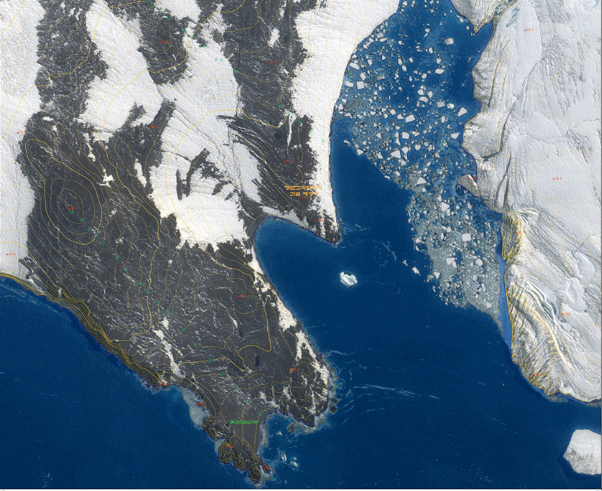
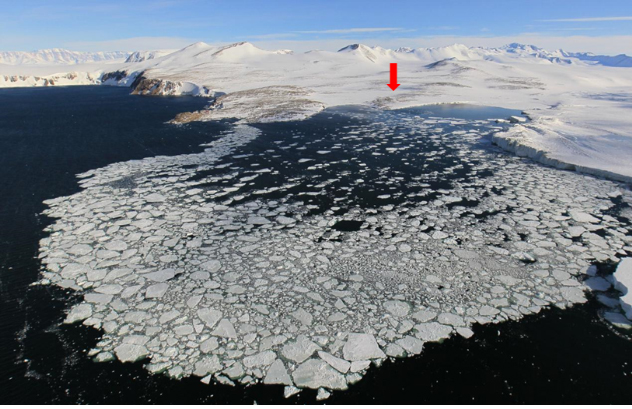
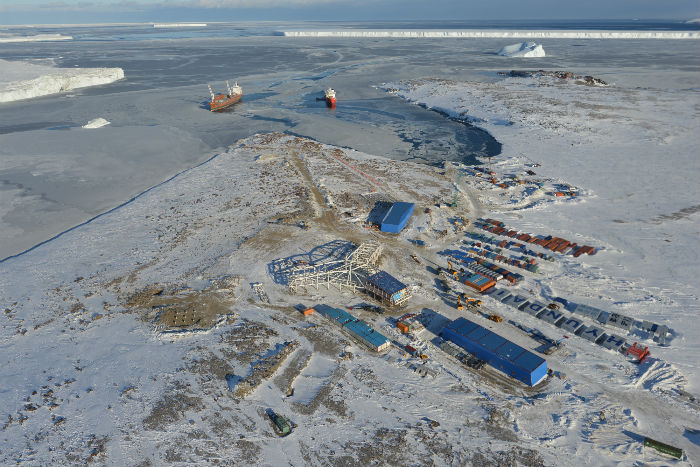
State-of-the-art technologies were used to build the base, as construction work is possible only for 65 days a year due to the extremely cold weather. The base was constructed using pre-built modules to reduce the time needed and environmentally friendly materials were used. Unlike regular piers, the pier at the base was built with stainless steel-reinforced blocks to resist the thawing of the ice in the Antarctic Sea. In a bid to minimize the base’s potential influence on the surrounding environment, waste heat and renewable energy, such as solar power and wind power, will be used to produce electricity and an energy-saving system will be introduced when it starts operations.
When the base is completed, it will be responsible for various research on climate change in Antarctica and other related subjects, along with the icebreaker Araon and the Antarctic King Sejong Station. The opening of the Jang Bogo station gives scientists an outpost deeper in the Antarctic, as the King Sejong station is situated on King George Island, at the northern tip of the continent.
“When Jang Bogo Station is completed, Korea will become the tenth nation in the world that has two or more permanent bases in the Antarctica,” said Kim Yang-soo, maritime industry policy director general at the Ministry of Oceans and Fisheries. “This will help improve our polar-related research as it can complement the Sejong base.”
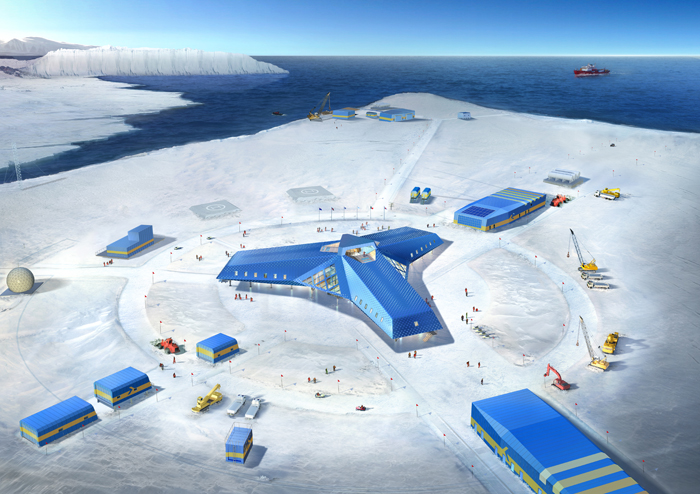
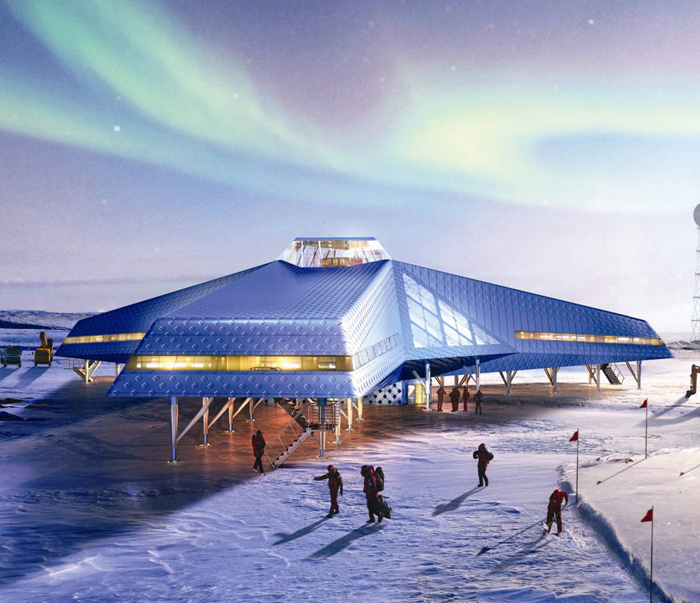
By Limb Jae-un
Korea.net Staff Writer
jun2@korea.kr

The Jang Bogo Antarctic Research Station is being built in Terra Nova Bay, Victoria Land, in the southeastern part of Antarctica. This is the country’s second base on the frozen continent after the Antarctic King Sejong Station was built in 1998. With the construction of the interior and exterior of the facility now underway, it is scheduled to be completed on March 10 this year.
The new base covers 4,458 square meters and has an aerodynamic outer shell to resist the strong winds that can blow at speeds of up to 65 kilometers per hour. It is also designed to provide a comfortable research and living environment even when Antarctic temperatures reach as low as minus 40 degrees Celsius. The base consists of 16 buildings used for both research and lodging and can accommodate 15 people in the winter and up to 60 people in the summer. The base is named after Jang Bogo, a general during the Silla Kingdom (57 B.C.- A.D. 935), who built the Cheonghaejin maritime trading base in the early 9th century to facilitate trade between the Tang Dynasty (618-907), Japan and Silla.


The Jang Bogo Antarctic Research Station is being built in Terra Nova Bay, Victoria Land, in the southeastern part of Antarctica. (Photo courtesy of the Ministry of Oceans and Fisheries)

An aerial view of the Jang Bogo Antarctic Research Station (Photo courtesy of the Ministry of Oceans and Fisheries)
State-of-the-art technologies were used to build the base, as construction work is possible only for 65 days a year due to the extremely cold weather. The base was constructed using pre-built modules to reduce the time needed and environmentally friendly materials were used. Unlike regular piers, the pier at the base was built with stainless steel-reinforced blocks to resist the thawing of the ice in the Antarctic Sea. In a bid to minimize the base’s potential influence on the surrounding environment, waste heat and renewable energy, such as solar power and wind power, will be used to produce electricity and an energy-saving system will be introduced when it starts operations.
When the base is completed, it will be responsible for various research on climate change in Antarctica and other related subjects, along with the icebreaker Araon and the Antarctic King Sejong Station. The opening of the Jang Bogo station gives scientists an outpost deeper in the Antarctic, as the King Sejong station is situated on King George Island, at the northern tip of the continent.
“When Jang Bogo Station is completed, Korea will become the tenth nation in the world that has two or more permanent bases in the Antarctica,” said Kim Yang-soo, maritime industry policy director general at the Ministry of Oceans and Fisheries. “This will help improve our polar-related research as it can complement the Sejong base.”


A computer rendering of the Jang Bogo Antarctic Research Station (Photo courtesy of the Ministry of Oceans and Fisheries)
By Limb Jae-un
Korea.net Staff Writer
jun2@korea.kr
Related Contents
Most popular
- China warmly welcomes first Korea-born giant panda Fu Bao
- First hearing-impaired K-pop act hopes for 'barrier-free world'
- Novelist Hwang's 'Mater 2-10' shortlisted for Int'l Booker Prize
- Expats could account for 7% of population in 20 years: report
- Nat'l Fire Agency picks 137 elite staff for deployment abroad














